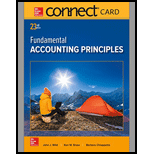
Concept explainers
Accounts Receivable:
The accounts receivable depicts the amount to be realized from the customers to whom the goods have been sold on credit by the business. Accounts receivable is an asset for the company as its collection increases the value of cash or amounts in bank and ultimately increases the assets part of the
Direct Write-off Method of Accounting:
In direct write-off method the bad debts are charged to expenses being incurred during the period in which specific invoices were distinctly regarded as bad debts. Also, under this method the recorded sales are not reduced but only the bad debts expenses are increased. This method is viable only for the values being written off which do not affect the books of accounts integrally since adopting such method will not bring about any change in the financial statements of the company and ultimately will not help the end-users in analyzing it and neither in decision-making on the basis of financial statements.
Also, another possible avenue in this case is to create a specific provision for bad debts for the period and account for the bad debts against the revenues earned during the period.
To explain: Method utilized in accounting for accounts receivable and realizable value of receivable accounts in the balance sheet of G Company.
Want to see the full answer?
Check out a sample textbook solution
Chapter 9 Solutions
Connect Access Card for Fundamental Accounting Principles
- Required Both solution. please provide. general accountarrow_forwardI want to this question answer for Financial accounting question not need ai solutionarrow_forwardMoti Bakery produces various baked goods. Utility costs are allocated to the products based on the baking time required for each product. Total utility costs of $270,000 are budgeted in a period when 540,000 total minutes of baking time are anticipated. If a batch of bagels bakes for 25 minutes, what amount of utility cost will be allocated to the bagels?arrow_forward

 AccountingAccountingISBN:9781337272094Author:WARREN, Carl S., Reeve, James M., Duchac, Jonathan E.Publisher:Cengage Learning,
AccountingAccountingISBN:9781337272094Author:WARREN, Carl S., Reeve, James M., Duchac, Jonathan E.Publisher:Cengage Learning, Accounting Information SystemsAccountingISBN:9781337619202Author:Hall, James A.Publisher:Cengage Learning,
Accounting Information SystemsAccountingISBN:9781337619202Author:Hall, James A.Publisher:Cengage Learning, Horngren's Cost Accounting: A Managerial Emphasis...AccountingISBN:9780134475585Author:Srikant M. Datar, Madhav V. RajanPublisher:PEARSON
Horngren's Cost Accounting: A Managerial Emphasis...AccountingISBN:9780134475585Author:Srikant M. Datar, Madhav V. RajanPublisher:PEARSON Intermediate AccountingAccountingISBN:9781259722660Author:J. David Spiceland, Mark W. Nelson, Wayne M ThomasPublisher:McGraw-Hill Education
Intermediate AccountingAccountingISBN:9781259722660Author:J. David Spiceland, Mark W. Nelson, Wayne M ThomasPublisher:McGraw-Hill Education Financial and Managerial AccountingAccountingISBN:9781259726705Author:John J Wild, Ken W. Shaw, Barbara Chiappetta Fundamental Accounting PrinciplesPublisher:McGraw-Hill Education
Financial and Managerial AccountingAccountingISBN:9781259726705Author:John J Wild, Ken W. Shaw, Barbara Chiappetta Fundamental Accounting PrinciplesPublisher:McGraw-Hill Education





